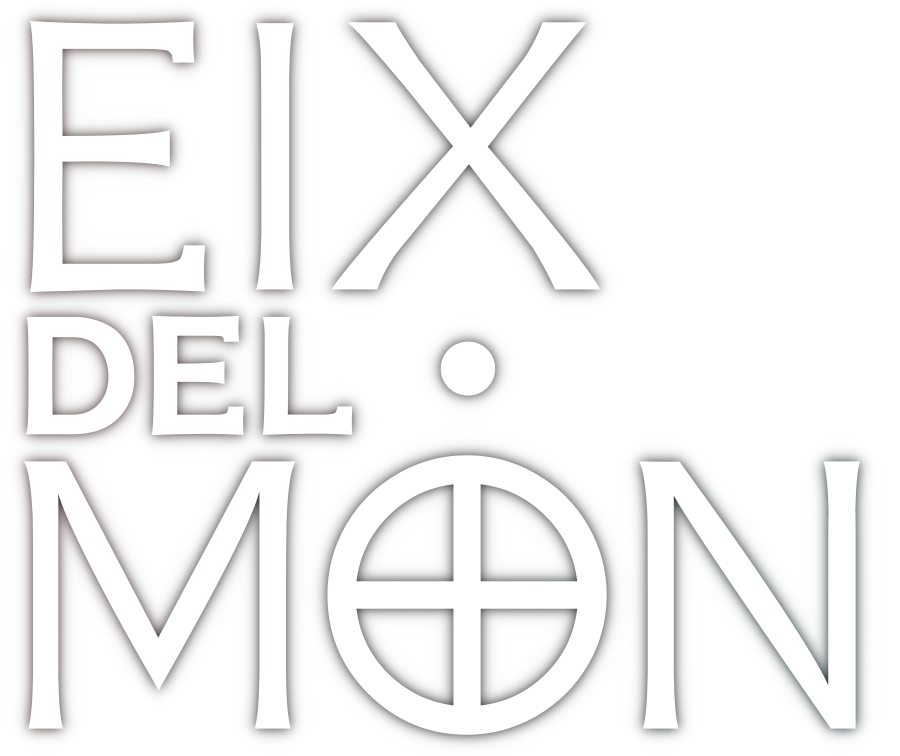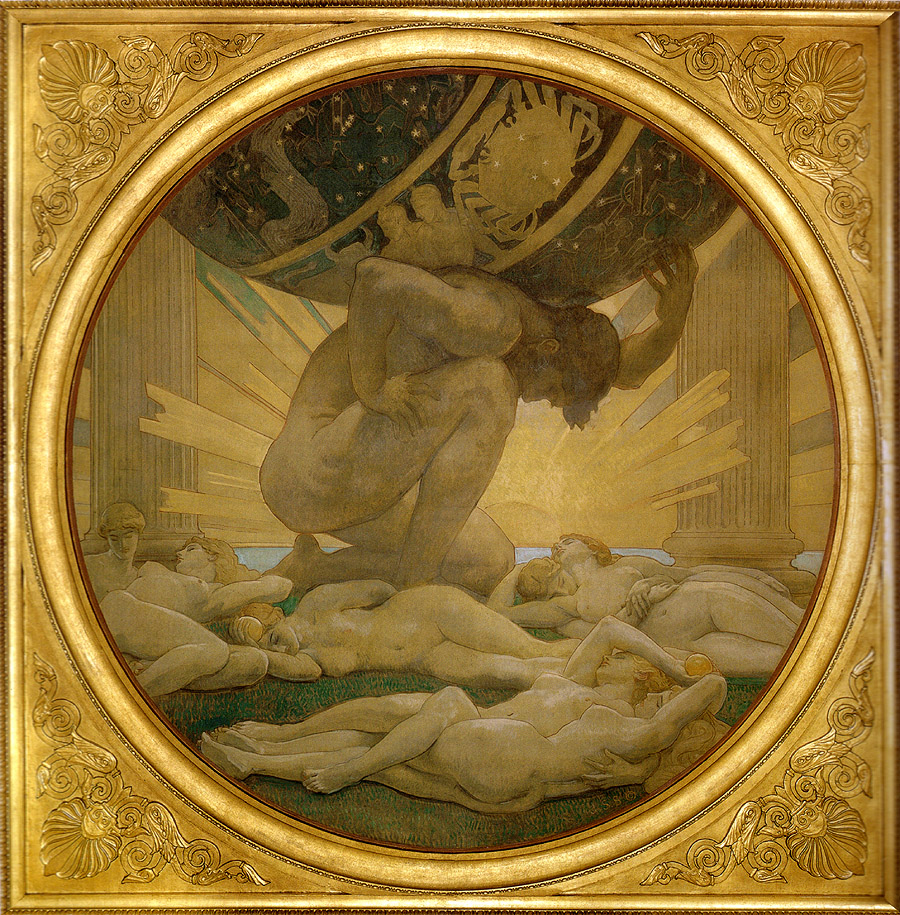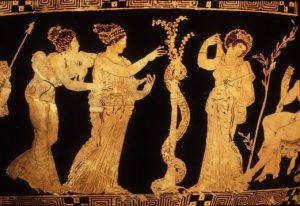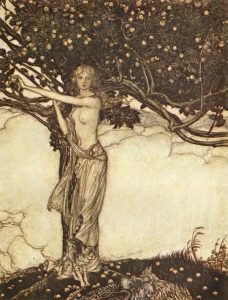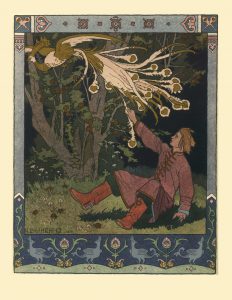John Singer Sargent, Atlas and the Hesperides, 1922-25. Oil on canvas, Diameter, unframed: 120 inches. © MFA with permission by fair use. On view at Ruth and Carl J. Shapiro Colonnade (Gallery 204B). Francis Bartlett Donation of 1912 and Picture Fund.
The Hesperides are an interesting figure. The 11th Labor of Hercules was to steal the golden apples from the Garden of the Hesperides:
These apples were kept in a garden at the northern edge of the world, and they were guarded not only by a hundred-headed dragon, named Ladon, but also by the Hesperides, nymphs who were daughters of Atlas, the titan who held the sky and the earth upon his shoulders.
- R. Wagner, A. Rackham, R. Scott, and D. McGlaun, Siegfried and the Twilight of the Gods: The Ring of the Nibelung – Volume 2 (Illustrated) (The Ring of the Nibelung by Richard Wagner), Amazon Digital Services LLC, 2011.
[Bibtex]@Book{WagnerRackhamScottEtAl2011, title = {Siegfried and the Twilight of the Gods: The Ring of the Nibelung - Volume 2 (Illustrated) (The Ring of the Nibelung by Richard Wagner)}, publisher = {Amazon Digital Services LLC}, year = {2011}, author = {Richard Wagner and Arthur Rackham and Robert Scott and Dan McGlaun}, month = {mar}, note = {“Siegfried and The Twilight of the Gods: The Ring of the Nibelung – Volume 2” is a modern (2011) English translation of the last 2 operas of German composer Richard Wagner’s Ring Cycle combined with 31 beautiful color illustrations by Arthur Rackham. The first two operas of The Ring Cycle are also available in the previously published Volume 1. This new translation makes it very easy to follow the storylines of “Siegfried” (Siegfried) and “The Twilight of the Gods” (Götterdämmerung), as these translations are written in the modern style of English unlike the 100 year or older translations that are generally available. New fans of The Ring Cycle will be able to focus on the story rather than struggling to interpret the nuances of old English prose. The integrity of Wagner’s characters has been preserved and Rackham’s illustrations add another dimension, helping bring the characters to life while also portraying the fantastic settings that form the backdrop to the drama. This book is a must have to accompany listening to, or watching, The Ring Cycle being performed. It's best viewed in color on Kindle for iPhone/iPad/iPod, Android/Blackberry or Kindle for PC or other devices where you can make the most of Rackham’s color illustrations. (Standard Kindle is currently black and white only). ** }, abstract = {Archive.org: www.archive.org/details/siegfriedtwiligh00wagn}, author_sort = {Wagner, Richard \& Rackham, Arthur \& Scott, Robert \& McGlaun, Dan}, calibreid = {205}, comment = {amazon:B004SJF626, mobi-asin:B004SJF626}, cover = {/home/trismegisto/Calibre Library/Richard Wagner/Siegfried and the Twilight of the Gods\_ The Ring of the Nibelung - Volume 2 (Illustrated) (The (205)/cover.jpg}, file = {WagnerRackhamScottEtAl2011.epub:media/trismegisto/Vitamin/Documents/Bibliography/WagnerRackhamScottEtAl2011.epub:ePUB;WagnerRackhamScottEtAl2011.pdf:media/trismegisto/Vitamin/Documents/Bibliography/WagnerRackhamScottEtAl2011.pdf:PDF}, formats = {epub}, identifiers = {mobi-asin:B004SJF626,amazon:B004SJF626}, keywords = {Arts & Photography, Music, Musical Genres, Opera, Theory; Composition & Performance}, languages = {eng}, library_name = {Calibre Library}, size = {3630404 octets}, tags = {Arts \& Photography, Music, Performing Arts, Reference}, timestamp = {2016-01-06}, title_sort = {Siegfried and the Twilight of the Gods: The Ring of the Nibelung - Volume 2 (Illustrated) (The Ring of the Nibelung by Richard Wagner)}, url = {https://archive.org/details/siegfriedtwiligh00wagn}, uuid = {7e1e3d48-7079-42dd-a268-08fac4003664} } - R. Wagner, A. Rackham, R. Scott, and D. McGlaun, The Rhinegold & the Valkyrie: The Ring of the Nibelung – Volume 1 (Illustrated) (The Ring of the Nibelung by Richard Wagner), Amazon Digital Services LLC, 2011.
[Bibtex]@Book{WagnerRackhamScottEtAl2011a, title = {The Rhinegold \& the Valkyrie: The Ring of the Nibelung - Volume 1 (Illustrated) (The Ring of the Nibelung by Richard Wagner)}, publisher = {Amazon Digital Services LLC}, year = {2011}, author = {Richard Wagner and Arthur Rackham and Robert Scott and Dan McGlaun}, month = mar, note = {“The Rhinegold \& The Valkyrie: The Ring of the Nibelung – Volume 1” is a modern (2011) English translation of the first 2 operas of German composer Richard Wagner’s Ring Cycle combined with 32 beautiful color illustrations by Arthur Rackham. Volume 2 with the remaining two operas will be available as a Kindle ebook shortly. This new translation makes it very easy to follow the storylines of “The Rhinegold” (Das Rheingold) and “The Valkyrie” (Die Walküre), as they are written in the modern style of English unlike the 100 year or older translations that are generally available. New fans of The Ring Cycle will be able to focus on the story rather than struggling to interpret the nuances of old English prose. The integrity of Wagner’s characters has been preserved and Rackham’s illustrations add another dimension, helping bring the characters to life while also portraying the fantastic settings that form the backdrop to the drama. This book is a must have to accompany listening to, or watching, The Ring Cycle being performed. It's best viewed in color on Kindle for iPhone/iPad/iPod, Android/Blackberry or Kindle for PC or other devices where you can make the most of Rackham’s color illustrations. (Standard Kindle is currently black and white only). ** }, abstract = {Archive.org: www.archive.org/details/rhinegoldvalkyri00wagn}, author_sort = {Wagner, Richard \& Rackham, Arthur \& Scott, Robert \& McGlaun, Dan}, calibreid = {206}, comment = {amazon:B004QOA59M, mobi-asin:B004QOA59M}, cover = {/home/trismegisto/Calibre Library/Richard Wagner/The Rhinegold \& the Valkyrie\_ The Ring of the Nibelung - Volume 1 (Illustrated) (The Ring of th (206)/cover.jpg}, file = {WagnerRackhamScottEtAl2011a.epub:media/trismegisto/Vitamin/Documents/Bibliography/WagnerRackhamScottEtAl2011a.epub:ePUB;WagnerRackhamScottEtAl2011a.pdf:media/trismegisto/Vitamin/Documents/Bibliography/WagnerRackhamScottEtAl2011a.pdf:PDF}, formats = {epub}, identifiers = {mobi-asin:B004QOA59M,amazon:B004QOA59M}, keywords = {Arts & Photography, Music, Musical Genres, Opera, Theory; Composition & Performance}, languages = {eng}, library_name = {Calibre Library}, rating = {6}, review = {“The Rhinegold & The Valkyrie: The Ring of the Nibelung – Volume 1” is a modern (2011) English translation of the first 2 operas of German composer Richard Wagner’s Ring Cycle combined with 32 beautiful color illustrations by Arthur Rackham. Volume 2 with the remaining two operas will be available as a Kindle ebook shortly. This new translation makes it very easy to follow the storylines of “The Rhinegold” (Das Rheingold) and “The Valkyrie” (Die Walküre), as they are written in the modern style of English unlike the 100 year or older translations that are generally available. New fans of The Ring Cycle will be able to focus on the story rather than struggling to interpret the nuances of old English prose. The integrity of Wagner’s characters has been preserved and Rackham’s illustrations add another dimension, helping bring the characters to life while also portraying the fantastic settings that form the backdrop to the drama. This book is a must have to accompany listening to, or watching, The Ring Cycle being performed. It's best viewed in color on Kindle for iPhone/iPad/iPod, Android/Blackberry or Kindle for PC or other devices where you can make the most of Rackham’s color illustrations. (Standard Kindle is currently black and white only).}, size = {3997238 octets}, tags = {Arts \& Photography, Music, Musical Genres, Opera, Theory; Composition \& Performance}, timestamp = {2016-01-06}, title_sort = {Rhinegold \& the Valkyrie: The Ring of the Nibelung - Volume 1 (Illustrated) (The Ring of the Nibelung by Richard Wagner), The}, url = {https://archive.org/details/rhinegoldvalkyri00wagn}, uuid = {c2a5094f-4c85-4d1a-a286-74b0e4d9708d} }
Some sources describe the Hesperides as Atlas’ daughters (hence, this painting, I assume), while others as the daughters of Hesperus (Venus as the Evening Star). The Golden Apple seems to be a rather recurrent one in European folklore:
- “Tsarevitch Ivan, the Fire Bird and the Gray Wolf” (Russian)
- “The Golden Bird” (German)
- “The Golden Mermaid” (German)
- “The Nine Peahens and the Golden Apples” (Serbian/Bulgarian)
- “Prâslea the Brave and the Golden Apples” (Romanian, where the thief is not a bird but a zmeu)
- “The Three Brothers and the Golden Apple” (Bulgarian, where the thief is not a bird but a zmey)
- “The White Snake” (German)
From Talbot’s The Saturn Myth:
Of the heaven-sustaining giant, there is no more popular figure than the Greek Atlas. In modern imagination Atlas is the lonely god bearing our earth on his shoulders. But Hesiod surely speaks for the original version when he writes: “And Atlas through hard constraint upholds the wide heaven with unwearying head and arms, standing at the borders of the earth, before the clear-voiced Hesperides.”1075 Pindar has Atlas “bearing up against heaven’s weight,”1076 while Ovid speaks of “strong Atlas who wears heaven on his shoulders.”1077 (The reader will recall that “heaven” means “the Cosmos.”)
[1075] Evelyn-White, Hesiod, the Homeric Hymns and Homerica, 117.
[1076] Pindar, Pythian Odes iv, 289.
[1077] Ovid, Metamorphoses, 168.
Atlas is not the only one:
In India numerous gods appear as personifications of the world mountain. Agni is a “supporting column,” or the “pillar of life,”1082 a god who “upholds the sky by his efficacious spells,”1083 and serves as the “axle” of the cosmic wheel or chariot.1084 “Agni is represented as the axis of the Universe, extending as a pillar between Earth and Heaven,” states Coomaraswamy.1085
[1082] Oldenberg, Vedic Hymns, 49.
[1083] Ibid., 61.
[1084] Op. cit., 65.
[1085] Ibid., 10.
- D. N. Talbott, The Saturn Myth, Doubleday, 1980.
[Bibtex]@Book{TalbottDavidTheSaturnMyth1980, title = {The Saturn Myth}, publisher = {Doubleday}, year = {1980}, author = {David N Talbott}, note = {1. This version fully reformatted for eBook devices, specifically Kindle, with endnotes and internal references fully hyperlinked. 2. To convert to other formats use Calibre eBook Management software, available to download free. 3. 1st revision August 2013. 2nd Revision Nov 2014 (filetype changed to .azw3, checked \& fixed non-functional hyperlinks \& minor corrections). Final revision Feb 2015 (minor corrections throughout \& all hyperlinks checked).}, file = {TalbottDavidTheSaturnMyth1980.azw3:media/trismegisto/Vitamin/Documents/Bibliography/TalbottDavidTheSaturnMyth1980.azw3:Amazon Kindle;TalbottDavidTheSaturnMyth1980.epub:media/trismegisto/Vitamin/Documents/Bibliography/TalbottDavidTheSaturnMyth1980.epub:ePUB}, owner = {trismegisto}, review = {Intrigued by Velikovsky’s claim that Saturn was once the pre-eminent planetary god, David Talbott resolved to examine its mythical character. “I wanted to know,” he wrote, “if ancient sources had a coherent story to tell about the planet . . . I had no inkling of the spectacular tale hidden in the chronicles.” In this startling re-interpretation of age-old symbolism Talbott argues that the “Great God” or “Universal Monarch” of the ancients was not the sun, but Saturn, which once hung ominously close to the earth, and visually dominated the heavens. Talbott’s close textual and symbolic analysis reveals the fundamental themes of Saturn imagery and proves that all of them—including the “cosmic ship”, the “island at the top of the world”, the “eye of heaven” and “the revolving temple” were based on celestial observations in the northern sky. In addition he shows how such diverse symbols as the Cross, “sun”-wheels, holy mountains, crowns of royalty and sacred pillars grew out of ancient Saturn worship. Talbott contends that Saturn's appearance at the time, radically different from today, inspired man's leap into civilization, since many aspects of early civilization can be seen as conscious efforts to re-enact or commemorate Saturn’s organization of his “celestial” kingdom. A fascinating look at ancient history and cosmology, The Saturn Myth is a provocative book that might well change the way you think about man’s history and the history of the universe.}, timestamp = {2016.01.22}, url = {https://archive.org/details/TalbottDavidTheSaturnMyth1980} } -
![[PDF]](https://www.eixdelmon.com/wp-content/plugins/papercite/img/pdf.png) Ovid, The Metamorphoses of Ovid Literally Translated into English Prose, with Copious Notes and Explanations. Books VIII – XV, Project Gutenberg, 1893.
Ovid, The Metamorphoses of Ovid Literally Translated into English Prose, with Copious Notes and Explanations. Books VIII – XV, Project Gutenberg, 1893.
[Bibtex]@Book{themetamorphoses26073gut, author = {Ovid}, title = {The Metamorphoses of Ovid Literally Translated into English Prose, with Copious Notes and Explanations. Books VIII - XV}, year = {1893}, note = {This e-text covers the second half, Books VIII-XV, of Henry T. Riley’s 1851 translation of Ovid’s Metamorphoses. The first half, Books I-VII, is already available from Project Gutenberg as e-text 21765. Note that this text, unlike the earlier one, is based solely on the 1893 George Bell reprint. The text includes characters that will only display in UTF-8 (Unicode) file encoding, including Greek words in the Notes: œ, Œ (oe ligature) κείρω, ἀκονιτὶ If any of these characters do not display properly, or if the apostrophes and quotation marks in this paragraph appear as garbage, you may have an incompatible browser or unavailable fonts. First, make sure that the browser’s “character set” or “file encoding” is set to Unicode (UTF-8). You may also need to change your browser’s default font. All Greek words have mouse-hover transliterations: Δηοῦς κόρη.}, publisher = {Project Gutenberg}, url = {http://archive.org/details/themetamorphoses26073gut}, file = {themetamorphoses26073gut.epub:media/trismegisto/Vitamin/Documents/Bibliography/themetamorphoses26073gut.epub:ePUB}, timestamp = {2016-07-28}, } -
![[PDF]](https://www.eixdelmon.com/wp-content/plugins/papercite/img/pdf.png) Ovid, The Metamorphoses of Ovid Literally Translated into English Prose, with Copious Notes and Explanations. Books I – VII, Project Gutenberg, 1893.
Ovid, The Metamorphoses of Ovid Literally Translated into English Prose, with Copious Notes and Explanations. Books I – VII, Project Gutenberg, 1893.
[Bibtex]@Book{themetamorphoses21765gut, author = {Ovid}, title = {The Metamorphoses of Ovid Literally Translated into English Prose, with Copious Notes and Explanations. Books I - VII}, year = {1893}, note = {This e-text covers the first half, Books I-VII, of Henry T. Riley’s 1851 translation of Ovid’s Metamorphoses. The second half, Books VIII-XV, is already available from Project Gutenberg as e-text 26073. The text includes characters that will only display in UTF-8 (Unicode) file encoding, including Greek words in the Notes: œ, Œ (oe ligature) κείρω, ἀκονιτὶ If any of these characters do not display properly, or if the apostrophes and quotation marks in this paragraph appear as garbage, you may have an incompatible browser or unavailable fonts. First, make sure that the browser’s “character set” or “file encoding” is set to Unicode (UTF-8). You may also need to change your browser’s default font. All Greek words have mouse-hover transliterations: Δηοῦς κόρη.}, publisher = {Project Gutenberg}, url = {http://archive.org/details/themetamorphoses26073gut}, file = {themetamorphoses26073gut.epub:media/trismegisto/Vitamin/Documents/Bibliography/themetamorphoses26073gut.epub:ePUB}, timestamp = {2016-07-28}, } -
![[PDF]](https://www.eixdelmon.com/wp-content/plugins/papercite/img/pdf.png) Ovid, Metamorphoses, Illustrated, Georgium Coruinum, Sigismundum Feyerabent & haeredes Vvigandi Galli, 1563.
Ovid, Metamorphoses, Illustrated, Georgium Coruinum, Sigismundum Feyerabent & haeredes Vvigandi Galli, 1563.
[Bibtex]@Book{ovidmetamorphoses1563, title = {Metamorphoses, Illustrated}, publisher = {Georgium Coruinum, Sigismundum Feyerabent \& haeredes Vvigandi Galli}, year = {1563}, author = {Ovid}, comment = {Published 1563 Usage Attribution-Noncommercial-No Derivative Works 3.0 Topics Ovid, Metamorphoses, German, Edition, 1563, Woodcuts, Virgil Solis, Publisher Feyerabent Identifier OvidMetamorphoses1563 Mediatype texts Licenseurl http://creativecommons.org/licenses/by-nc-nd/3.0/ Scanner Internet Archive HTML5 Uploader 1.5.2 Identifier-access http://archive.org/details/OvidMetamorphoses1563 Identifier-ark ark:/13960/t75t67t8b Ppi 150 Ocr ABBYY FineReader 9.0 1563 Illustrated Edition of Ovid's Metamorphoses Author: Ovid (Publius Ovidius Naso) Title: Metamorphoses Publisher: Georg Corvin, Sigismund Feyerabent & Wigandi Galli (Georgium Coruinum, Sigismundum Feyerabent & haeredes Vvigandi Galli) Poet: Johannes Posthius von Germersheim (old spelling Germersheim) Illustrations: Virgil Solis (Woodcuts) Printed in Frankfurt, Germany 1563. (Impressum Francofurti, MDLXIII) Collection: The Norris Museum, St Ives, Cambridgeshire, UK. Catalogue Numbers 90 and 200. Digitization: By Dr Chris Thomas, on behalf of the Norris Museum Nikon DS5200 Camera with Flash RAW (Nikon NEF) Format 6000pixels x 4000pixels (originals with Norris Museum) Cropped and edited in Corel AfterShot Pro 1.2.0.7 Exported as 1600pixel x 1200pixel images and converted to PDF book Year 1563 Language Latin Collection opensource}, file = {OvidMetamorphoses1563.pdf:media/trismegisto/Vitamin/Documents/Bibliography/OvidMetamorphoses1563.pdf:PDF}, keywords = {Ovid, Metamorphoses, German, Edition, 1563, Woodcuts, Virgil Solis, Publisher Feyerabent}, timestamp = {2016-03-14}, url = {https://archive.org/details/OvidMetamorphoses1563} }
